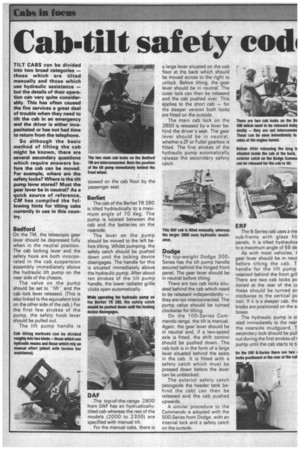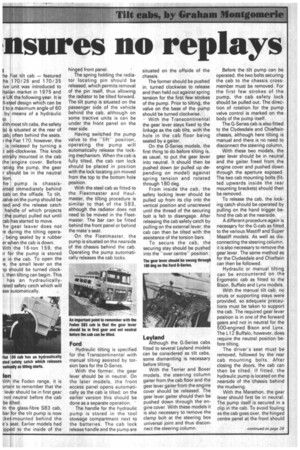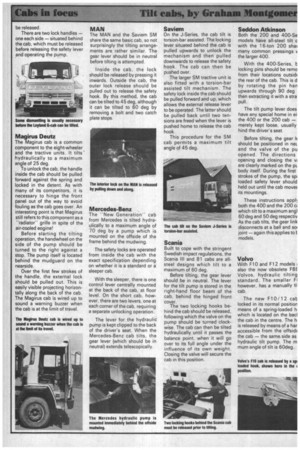Cab-tilt safety cod nsures no replays
Page 28

Page 29

Page 30

If you've noticed an error in this article please click here to report it so we can fix it.
TILT CABS can be divided into two broad categories — those which are tilted manually and those which use hydraulic assistance — but the details of their operation can vary quite considerably. This has often caused the fire services a great deal of trouble when they need to tilt the cab in an emergency and the driver is either incapacitated or has not had time to return from the telephone.
So although the basic method of tilting the cab might be known, there are several secondary questions which require answers before the cab can be moved. For example, where are the safety locks? Where is the tilt pump lever stored? Must the gear lever be in neutral? As a quick source of reference, CM has compiled the following hints for tilting cabs currently in use in this country.
Bedford .
On the TM, the telescopic gear lever should be depressed fully when in the neutral position. The cab locking lever and the safety hook are both incorporated in the cab suspension assembly immediately above the hydraulic lift pump on the near side of the chassis.
The valve on the pump should be set to "lift" and the cab lock lever released. (This is also linked to the equivalent lock on the other side of the cab.) For the first few strokes of the pump, the safety hook lever should be pulled out.
The lift pump handle is stowed on the cab floor by the passenger seat.
The cab of the Berliet TR 280 is tilted hydraulically to a maximum angle of 70 deg. The pump is located between the cab and the batteries on the nearside.
The lever on the pump should be moved to the left before tilting. Whilst pumping, the safety catch should be pushed down until the locking device disengages. The handle for this is situated immediately above the hydraulic pump. After about ten strokes of the tilt pump handle, the lower radiator grille clicks open automatically
The top-of-the-range 2800 from DAF has an hydrualicaNytilted cab whereas the rest of the models (2000 to 2300) are specified with manual tilt.
For the manual cabs, there is a large lever situated on the cab floor at the back which should be moved across to the right to unlock. Before tilting, the gear lever should be in neutral. The outer lock can then be released and the cab pushed over. This applies to the short cab — for the sleeper version both locks are fitted on the outside.
The main cab lock on the 2800 is released by a /ever behind the driver's seat. The gear lever should be in neutral. whether a ZF or Fuller gearbox is fitted. The first strokes of the hydraulic pump automatically release the secondary safety catch.
Dodge
The top-weight Dodge 300Series has the tilt pump handle secured behind the hinged front panel. The gear lever should be in neutral before tilting.
There are two cab locks situated behind the cab which need to be released independently — they are not interconnected. The pump valve should be turned clockwise for tilting.
On the 100-Series Commando range, the tilt is manual. Again, the gear lever should be in neutral and, if a two-speed .axle is fitted, the shift control should be pushed down. The cab lock is in the form of a large lever situated behind the seats in the cab. It is fitted with a safety catch which must be pressed down before the lever can be unblocked.
The exterior safety catch (alongside the header tank behind the cab) can then be released and the cab pushed upwards.
A similar procedure to the Commando is adopted with the 500-Series from Dodge, with an internal lock and a safety catch on the outside. The 8-Series cab uses a me sub-frame with glass fih panels. It is tilted hydraulica to a maximum angle of 68 de
As with most vehicles, t gear lever should be in neut before tilting the cab. T handle for the lift pump retained behind the front gril There are two cab locks pa tioned at the rear of the CE these should be turned an clockwise to the vertical pa tion. If it is a sleeper cab, thE knobs are positioned on the si boxes.
The hydraulic pump is si ated immediately to the rear the nearside mudguard. T secondary lock should be pull out during the first strokes of pump until the cab starts to ti
he 7-iat tilt cab — featured he 170/26 and 170/35 :ive unit was introduced to Italian market in 1975 and e UK the following year. It is II-steel design which can be to a maximum angle of 60 by means of a hydraulic ip.
iiith most tilt cabs, the safety (s) is situated at the rear of .7,ab, often behind the seats. the Fiat 170, however, the is released by turning a 3 anti-clockwise. This knob )ntrally mounted in the cab the engine cover. Before -ating the pump, the gear r should be in the neutral tion.
he pump is chassismted immediately behind cab on the offisde. To tilt, ralve on the pump should be ried and the release catch handle of which projects • the pump) pulled out until cab has started to move.
he gear leaver does not re during the tilting opera, being sealed by a rubber er vs,hen the cab is down. Vith the 16-ton 1 59, the ir for the pump is stored e in the cab. To open the re, .he small lever on the ip should be turned clock), then tilting can begin. This
has an hydraulicallyratel safety catch which will ase 3utomaticaliy.
Jen
Vith the Foden range, it is ortant to remember that the lever should be in first gear not neutral before the cab be tilted.
In the glass-fibre 583 cab, bar for the tilt pump is now cket-mounted behind the es seat. Earlier models had ipped to the inside of the The spring holding the radiator locating pin shoLed be released, which permits removal of the pin itself, thus allowing the radiator to be tilted forward. The tilt pump is situated on the passenger side of the vehicle behind the cab, although on some tractive units is can be under the front panel on the near side.
Having switched the pump valve to the "lift" position, operating the pump will automatically release the locking mechanism. When the cab is fully tilted, the cab ram lock should be placed in position with the lock locating pin moved from the top to the bottom hole position.
With the steel cab as fitted to the Fleetmaster and Haulmaster, the tilting procedure is similar to that of the 583, although the radiator does not need to be moved in the Fleetmaster. The bar can be fitted behind the front panel or behind the mate's seat.
On the Fleetmaster. the pump is situated on the nearside of the chassis behind the cab. Operating the pump automatically releases the cab locks.
Ford
Hydraulic tilting is specified for the Transcontinental with manual tilting assisted by torsion bars for the D-Series.
With the former, the gear lever should be in neutrat. On the later models, the front access panel opens automatically as the cab is tilted; on the earlier version this should be done as a separate operation. '
The handle for the hydraulic pump is stored in the tool stowage compartment next to the batteries. The cab lock release handle and the pump are situated on the offside of the chassis.
The former should be pushed in, turned clockwise to release and then held out against spring tension for the first few strokes of the pump. Prior to tilting, the valve on the base of the pump should be turned clockwise.
• With the Transcontinental the gear lever stays fixed to the linkage as the cab tilts, with the hole in the cab floor being sealed by a gaiter.
On the D-Series models, the first thing to do before tilting is, as usual, to put the gear lever into neutral. It should then be pushed down (or pulled up de pending on model) against spring tension and rotated through 180 deg.
From inside the cab, the safety locking lever should be pulled up from its clip into the vertical position and unscrewed until the thread of the securing bolt is felt to disengage. After releasing the cab safety catch by pulling on the external lever, the cab can then be tilted with the assistance of the torsion bars.
To secure the cab, the securing stay should be pushed into the -over centreposition.
The gear lever should be swung through 180 deg on the Ford 0-Series.
Although the 6-Series cabs fitted to several Leyland models can be considered as tilt cabs, some dismantling is necessary before tilting.
With the Terrier and Boxer models, the steering column gaiter from the cab floor and the gear lever gaiter from the engine cover should be released. The gear lever gaiter should then be pushed down through the engine cover. With these models it is also necessary to remove the clamp bolt at the steering box universal joint and thus disconnect the steering column. Before the tilt pump can be operated, the two bolts securing the cab to the chassis crossmember must be removed. For the first few strokes of the pump, the cab safety lock should be pulled out. The direction of rotation for the pump valve control is marked on the body of the pump itself.
The 6-Series cab is also fitted to the Clydesdale and Chieftain chassis, although here tilting is manual and there is no need to disconnect the steering column.
With these two models, the gear lever should be in neutral and the gaiter freed from the engine cover and pushed down through the aperture exposed.. The two cab mounting bolts (fitted upwards inside the rear mounting brackets) should then be removed.
To release the cab, the locking catch should be operated by pulling on the hand trigger behind the cab at the nearside.
A different procedure again is necessary for the 6-cab as fitted to the various Mastiff and Super Mastiff models. As well as disconnecting the steering column, it is also necessary to remove the gear lever. The same method as for the Clydesdale and Chieftain can then be followed.
Hydraulic or manual tilting can be encountered on the Ergomatic cab as fitted to the Bison, Buffalo and Lynx models.
With the manual tilt cab, no struts or supporting stays were provided, so adequate precautions must be taken to support the cab. The required gear lever position is in one of the forward gears and not in neutral for the 500-engined Bison and Lynx. The L12 Buffalo, however, does require the neutral position before tilting.
The driver's seat must be removed, followed by the rear cab mounting bolts. After closing the doors, the cab can then be tilted. If fitted, the hydraulic pump is located on the nearside of the chassis behind the mudwing.
With the Marathon, the gear lever should first be in neutral. The pump itself is secured in a clip in the cab. To avoid fouling as the cab goes over, the hinged centre panel at the front should There are two lock handles — one each side — situated behind the cab, which must be released before releasing the safety lever and operating the pump.
Magirus Deutz
The Magirus cab is a common component to the eight-wheeler and the tractive units. It tilts hydraulically to a maximum angle of 25 deg.
To unlock the cab, the handle inside the cab should be pulled forward against the spring and locked in the detent. As with many of its competitors, it is necessary to hinge the front panel out of the way to avoid fouling as the cab goes over. An interesting point is that Magirus still refers to this component as a "radiator" grille in spite of the air-cooled engine!
Before starting the tilting operation, the handwheel on the side of the pump should be turned to the right against a stop. The pump itself is located behind the mudguard on the nearside.
Over the first few strokes of the handle, the external lock should be pulled out. This is easily visible projecting horizontally along the back of the cab. The Magirus cab is wired up to sound a warning buzzer when the cab is at the limit of travel. The MAN and the Saviem SM share the same basic cab, so not surprisingly the tilting arrangements are rather similar. The gear lever should be in neutral before tilting is attempted.
Inside the cab, the lock should be released by pressing it inwards. Outside the cab, the outer lock release should be pulled out to release the safety hook. By this method, the cab can be tilted to 45 deg, although it can be tilted to 60 deg by removing a bolt and two catch plate stops.
The "New Generation"' cab from Mercedes is tilted hydraulically to a maximum angle of 70 deg by a pump which is mounted on the offside of the frame behind the mudwing.
The safety locks are operated from inside the cab with the exact specification depending on whether it is a standard or a sleeper cab.
With the sleeper, there is one control lever centrally mounted at the back of the cab, at floor level. On the short cab, however, there are two levers, one at each corner of the cab, requiring a separate unlocking operation.
The lever for the hydraulic pump is kept clipped to the back of the driver's seat. When the Mercedes-Benz cab tilts, the gear lever (which should be in neutral) extends telescopically. On the J-Series, the cab tilt is torsion-bar assisted. The locking lever situated behind the cab is pulled upwards to unlock the mechanism and then pulled downwards to release the safety hook, The cab can then be pushed over.
The larger SM tractive unit is also fitted with a torsion-bar assisted tilt mechanism. The safety lock inside the cab should be pulled forward and up, which allows the external release lever to be operated. The latter should be pulled back until two tensions are freed when the lever is pushed home to release the cab hook.
This procedure for the SM cab permits a maximum tilt angle of 45 deg.
Scania
Built to cope with the stringent Swedish impact regulations, the Scania Ill and 81 cabs are allsteel designs which tilt to a maximum of 60 deg, Before tilting, the gear lever should be in neutral. The lever for the tilt pump is stored in the right-hand floor beam of the cab, behind the hinged front cover.
The two locking hooks behind the cab should be released, following which the valve on the pump should be turned clockwise. The cab can then be tilted hydraulically until it passes the balance point, when it will go over to its full angle under the influence of its own weight. Closing the valve will secure the cab in this position. Both the 200 and 400-Se models have all-steel tilt c with the 16-ton 200 shar many common pressings v the larger 400.
With the 400-Series, It locking pins should be rerno from their locations outsid( the rear of the cab. This is d by rotating the pin han upwards through 90 deg then extracting it with a stra
The tilt pump lever does have any special home in eithe 400 or the 200 cab — merely kept loose, usually hind the driver's seat.
Before tilting, the gear It should be positioned in net, and the valve of the pu opened. The directions opening and closing the vi are clearly marked on the pi. body itself. During the first strokes of the pump, the spi loaded safety lever should held out until the cab move5 its mountings.
These instructions appk, both the 400 and the 200 ci which tilt to a maximum angl 60 deg and 50 deg respectiv As the cab tilts, the gear link disconnects at a ball and sos joint — again this applies to t models.
Volvo
With P10 and Fl 2 models also the now obsolete F8E Volvos, hydraulic tilting standard. The smaller F1 however, has a manually til cab.
The new F10 /12 cal locked in its normal position means of a spring-loaded h• which is located on the bad! the cab in the centre. The h is released by means of a har accessible from the offsid€ the cab — the same. side as hydraulic tilt pump. The m mum angle of tilt is 60deg.
































































































